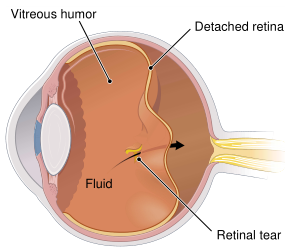Errors of Refraction
If the eyeball is too long, images will form in front of the retina. To focus clearly, an object must be brought closer to the eye. This condition of nearsightedness is technically called myopia. The opposite condition is hyperopia, or farsightedness, in which the eyeball is too short and images form behind the retina. Objects must be moved away from the eye for the focus to be clear. The same effect is produced by presbyopia, which accompanies aging. The lens loses elasticity and can no longer accommodate for near vision. The person becomes increasingly farsighted. An astigmatism is an irregularity in the curve of the cornea or lens that distorts light entering the eye and blurs vision. Glasses can compensate for most of these impairments.
Infection
Several microorganisms can cause conjunctivitis (inflammation of the conjunctiva). This is a highly infectious disease commonly called pinkeye.
The bacterium Chlamydia trachomatis causes trachoma, inflammation of the cornea and conjunctiva that results in scarring. This disease is rare in the United States but is a common cause of blindness in under-developed countries, although it is easily cured with sulfa drugs and antibiotics.
Gonorrhea is the usual cause of an acute conjunctivitis in newborns called ophthalmia neonatorum. An antibiotic ointment is routinely used to prevent such eye infections in newborns.
Disorders of the Retina
Retinal detachment, separation of the retina from the underlying layer of the eye (the choroid), may be caused by a tumor, hemorrhage, or injury to the eye (Fig. 1). This condition interferes with vision and is commonly repaired with laser surgery.

FIGURE 1. Retinal detachment. (Reprinted with permission from Smeltzer SC, Bare BG. Brunner & Suddarth's Textbook of Medical-Surgical Nursing. 9th Ed. Philadelphia: Lippincott Williams & Wilkins, 2000.)
Degeneration of the macula, the point of sharpest vision, is a common cause of visual problems in the elderly. When associated with aging, this deterioration is described as age-related macular degeneration (AMD). Macular degeneration typically affects central vision but not peripheral vision. Other causes of macular degeneration are drug toxicity and hereditary diseases.
上一篇:医学文章阅读——The Neuron
下一篇:医学文章阅读——The Eye and Vision

微信公众号搜索“译员”关注我们,每天为您推送翻译理论和技巧,外语学习及翻译招聘信息。